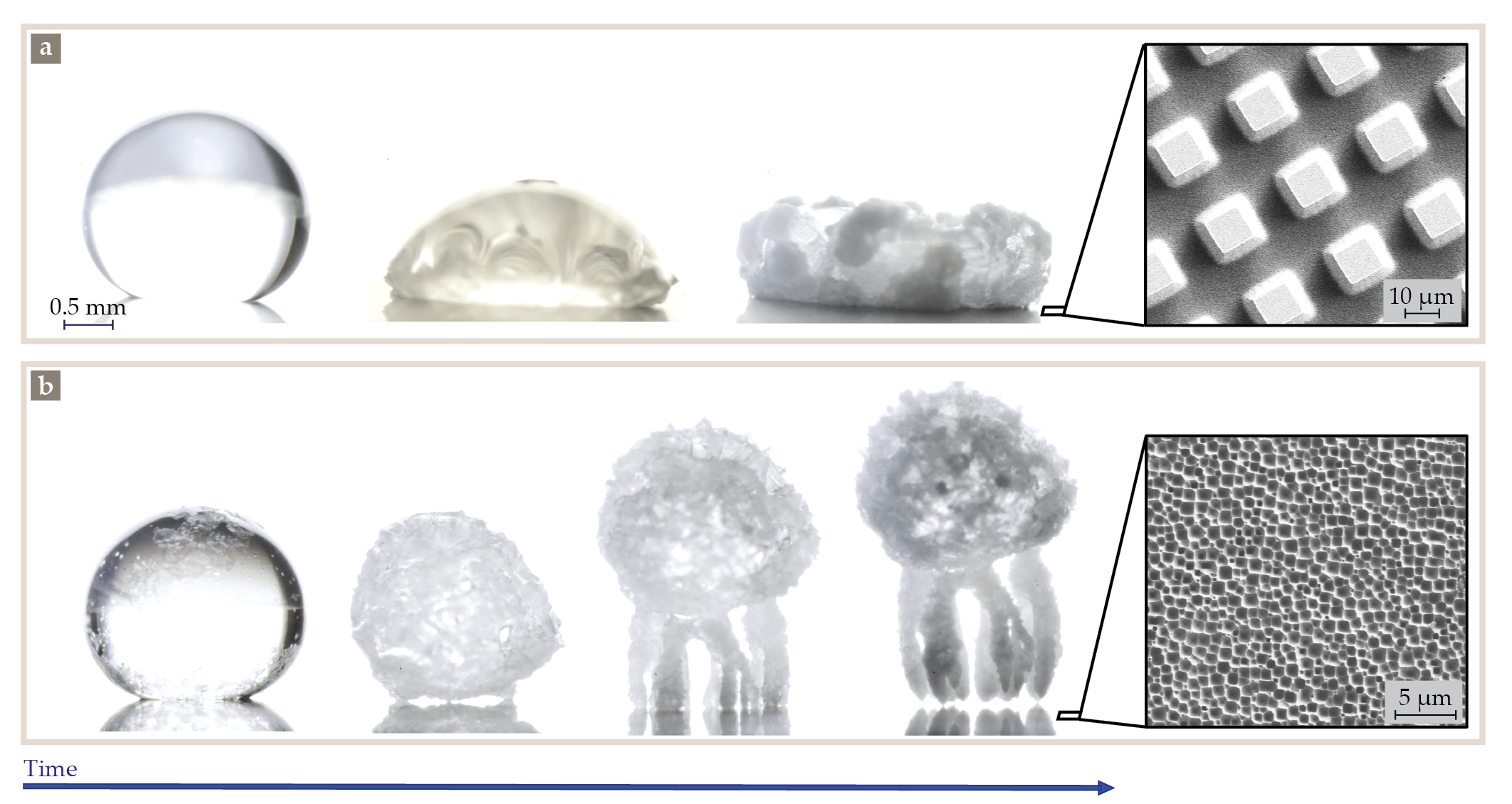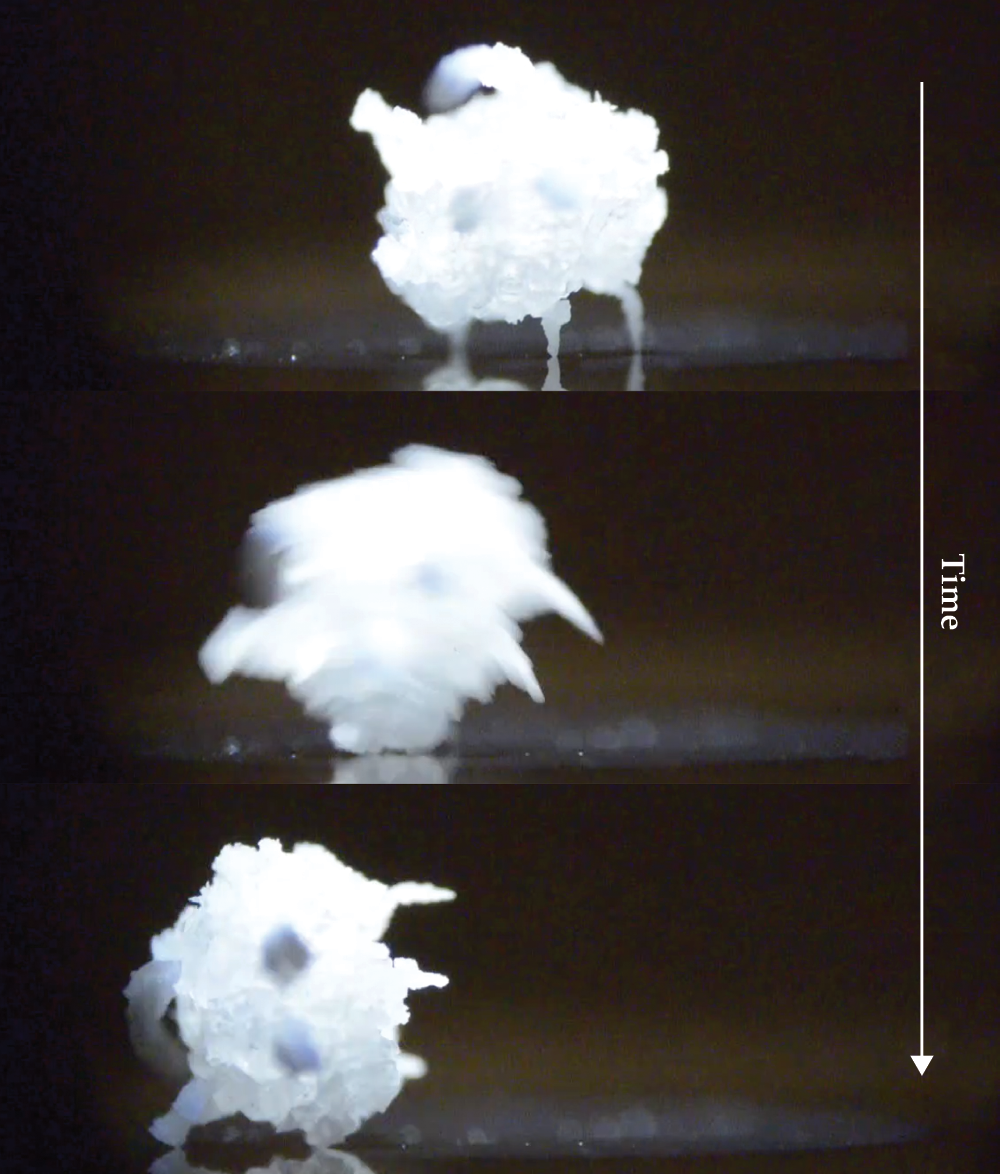Self-removing salt crystals
DOI: 10.1063/pt.ntmp.zjek
Water is indispensable not only in people’s daily lives but also in industry. Fresh water is used frequently in power plants to transform thermal energy into mechanical energy by the spinning of a steam turbine. With the escalating threats to the freshwater supply posed by climate change, it is more crucial than ever to preserve the planet’s limited water resources. Of the total water on Earth, a mere 1% is fresh water in liquid form, and 2% is fresh water locked in solid forms, such as glaciers and snowcaps. The remaining 97% is salt water, found in oceans and seas.
Harnessing salt water for industrial processes could significantly alleviate the strain on freshwater demands. Yet substituting salt water for fresh water in industrial processes is not a straightforward solution. Both fresh and saline waters contain dissolved minerals that tend to accumulate on surfaces. A familiar example is the soap scum that appears in sinks and showers. Mineral buildup is an even bigger problem in industrial processes, particularly those involving phase changes such as evaporation or boiling. The problem would only worsen if the more plentiful but more mineral-rich salt water is used.
Self-cleaning materials would go a long way toward reducing inefficiencies in the system, but existing coatings aren’t doing the trick. The key might be nanoengineering surface textures.
My colleagues and I in the Kripa Varanasi research group at MIT studied drop evaporation and the effects of different surfaces. When salt water on a hydrophobic surface evaporates, spherical structures of salt crystals form. Those structures are part of the problematic buildup on surfaces. And under the right circumstances, the structures remove themselves from the surface.
A scaly problem
Mineral buildup, a process known as scaling, is typically caused by the accumulation of calcium or magnesium salts. It poses a range of detrimental and costly effects that can disrupt crucial industrial processes. Scaling impedes flow in pipes and other fluid transmission systems, hinders heat transfer in boilers and heat exchangers, and reduces the efficiency of chemical reactors.
Existing approaches to combat mineral scaling primarily rely on chemicals or manual cleaning methods. Antiscalants, although effective, are typically toxic and can pose major risks to local ecosystems when discharged into the environment. Manual cleaning is expensive and time-consuming, and it doesn’t prevent subsequent mineral accumulation.
Those challenges underscore the necessity for alternative solutions that sustainably and efficiently address scaling. One approach is interfacial engineering, which is designed to modify the material properties of the surface that is exposed to water and dissolved minerals. With thicknesses ranging from 10 to 1000 nm, interfacial coatings are significantly thinner than the underlying bulk industrial materials they are employed to protect.
Crystal critters
The Varanasi group was investigating such interfacial coatings when we noticed an unusual behavior: scales falling away from the material. Crystals formed from evaporating drops, as expected, but when the material was heated to above 50 °C, the crystals self-ejected from the coating. Tall, thin structures grew and pushed the salt-crystal structure upward, away from the surface. Their resemblance to jellyfish (see figure
Figure 1.

Crystal-critter growth. A drop of salt water evaporates and leaves behind salt crystals. The structure of those crystals is dependent on the texture of the surface. (a) On a microtextured superhydrophobic surface, the gaps between the pillars are large enough for salt crystals to embed themselves in the surface. The overall salt-crystal structure spreads out and clings to the surface. (b) In contrast, a nanotextured surface does not have large enough gaps for the crystals to grow into. Instead, evaporative flux at the 90 °C surface causes crystalline legs to grow such that minerals are ejected from the material. (Adapted from S. A. McBride, H.-L. Girard, K. K. Varanasi, Sci. Adv. 7, eabe6960, 2021.)

We discovered the unusual behavior while investigating why superhydrophobic materials initially perform well for antifouling purposes but eventually fail after sustained exposure to natural water sources. Superhydrophobic materials are materials that repel water so strongly that a drop of water on the surface would appear almost perfectly round when viewed from the side; the contact angle is greater than 150°. Typically, superhydrophobicity arises from a micron-scale material texture, and our investigation determined that those were the cause of the antifouling failure. As shown in figure
But superhydrophobic materials can also be made with nanoscale, rather than micron-scale, textures, as shown in figure
Figure 2.

Descaling surfaces is often a toxic process. But when salt crystals grow on surfaces they cannot cling to, the balls of crystals rise from the surface on spindly crystal legs. Once evaporation is complete, there is little force keeping the mineral structures adhered to the surface, and the crystals often roll or fall off the surface. The detachment can happen in as quickly as four minutes.

Although our initial investigation into crystal critters used pure salt water, real-world saline sources, such as ocean water, contain various other substances. We found that the addition of model contaminants—including calcium salts, colloidal particles, and surfactant—enhances the self-ejection effect. When other substances are present, the solubility limit of sodium chloride decreases. That decrease hastens the formation of crystals during evaporation and thus accelerates the self-ejection.
The discovery of the crystal-critter phenomenon opens up the possibility of using salt water as an alternative to fresh water for some industrial processes. It may be applicable to heat-exchange processes involving phase change, such as spray cooling of hot surfaces, which already relies on the evaporation of water drops or films on hot surfaces for efficient heat exchange. By integrating crystal self-ejection into such systems, engineers may be able to design sustainable processes that utilize waste brine instead of limited freshwater resources.
References
► S. A. McBride, H.-L. Girard, K. K. Varanasi, “Crystal critters: Self-ejection of crystals from heated, superhydrophobic surfaces,” Sci. Adv. 7, eabe6960 (2021). https://doi.org/10.1126/sciadv.abe6960
► S. A. McBride, J. R. Lake, K. K. Varanasi, “Self-ejection of salts and other foulants from superhydrophobic surfaces to enable sustainable anti-fouling,” J. Chem. Phys. 158, 134721 (2023). https://doi.org/10.1063/5.0142428
► J. Goldberg, “These strange salt ‘creatures’ could help unclog power plant pipes,” Scienceshots (28 April 2021).
► F. Geyer et al., “When and how self-cleaning of superhydrophobic surfaces works,” Sci. Adv. 6, eaaw9727 (2020). https://doi.org/10.1126/sciadv.aaw9727
More about the Authors
Samantha McBride is an assistant professor in the department of mechanical engineering and applied mechanics at the University of Pennsylvania. She conducted the work described in the work described here while she was a PhD student at MIT.

